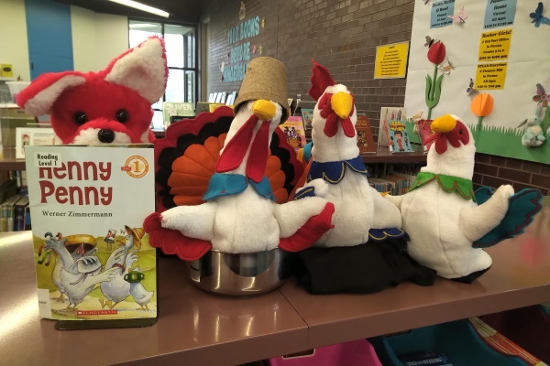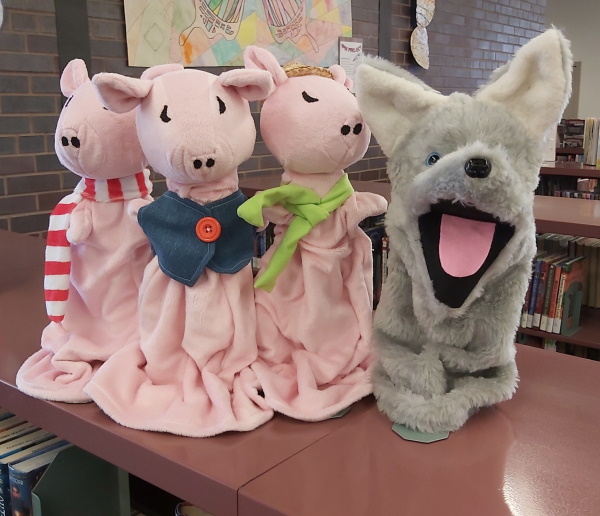Fables, Folktales, and Puppets for the Pandemic
As a children’s librarian, I started rethinking the messages of classic folktales and fables. Viewed through the lens of COVID-19, Henny Penny, Joseph Had a Little Overcoat, and The Lion & the Mouse held new meanings for me. They were stories I had shared with children over the years, either read aloud or told with props and puppets, but it turned out that I didn’t know what I didn’t know.
“You don’t know what you don’t know.” This was a phrase one of my previous coworkers liked to use frequently, but I never truly appreciated her words until the COVID-19 pandemic changed everything. Suddenly, toilet paper went from being a banal commodity to a coveted luxury as the stuff became scarce overnight. We masked up, kept our distance from others, communicated via Zoom meetings, and contemplated the moral of this strange real-life story.
As a children’s librarian, I started rethinking the messages of classic folktales and fables. Viewed through the lens of COVID-19, Henny Penny, Joseph Had a Little Overcoat, and The Lion & the Mouse held new meanings for me. They were stories I had shared with children over the years, either read aloud or told with props and puppets, but it turned out that I didn’t know what I didn’t know.

Henny Penny, Cocky Locky, Turkey Lurkey, and Foxy Loxy turned up in my office several months ago. Jane Lindsay, a retired fellow children’s librarian, had spent the winter months sewing puppets for her daughter (also a librarian) and had made a Henny Penny set for my library as well. The puppets were beautiful works of art and a labor of love created during shutdown. They signaled a brighter future when we could all be together again sharing well-known stories with families.
 Jane and I had performed Henny Penny as a puppet show many times, usually at summer festivals with hundreds of children in attendance. I had also read the story aloud at storytimes, favoring the version illustrated by H. Werner Zimmermann (Scholastic). In his whimsical retelling, the foolish fowl rush off to tell the king the sky is falling while donning cooking pots as head protection. In the past, Werner made several visits to our library and delighted children when he handed out cookware and they got to act out the story while clutching the pot handles to keep their makeshift helmets on while following each other around the room. With the ill-fitting headgear obscuring their view, the children “went along and they went along and they went along” — right into Foxy Loxy’s cave!
Jane and I had performed Henny Penny as a puppet show many times, usually at summer festivals with hundreds of children in attendance. I had also read the story aloud at storytimes, favoring the version illustrated by H. Werner Zimmermann (Scholastic). In his whimsical retelling, the foolish fowl rush off to tell the king the sky is falling while donning cooking pots as head protection. In the past, Werner made several visits to our library and delighted children when he handed out cookware and they got to act out the story while clutching the pot handles to keep their makeshift helmets on while following each other around the room. With the ill-fitting headgear obscuring their view, the children “went along and they went along and they went along” — right into Foxy Loxy’s cave!
I had always thought of the story as a cautionary tale about the perils of being led astray by a bad actor. With the pandemic, I considered the titular character’s role more closely. Henny Penny earnestly believes she needs to tell the authorities about a grave danger, but without any research or investigation, she inadvertently spreads misinformation. Misinformation, repeated over and over, spreads quickly and attracts an audience. Foxy Loxy sees an opportunity to profit from the misguided beliefs of Henny Penny and her followers. After all, his feathered friends arrive with saucepans and casserole dishes at the ready; he literally finds a bird in every pot, and the inevitable ending ensues.
 I had undertaken some sewing projects myself during the pandemic. With stores closed or only offering online service, finding fabric was a challenge, so I dug into my stash and came upon some drapery ends. Through careful cutting and piecing, the material covered two throw pillows and transformed into dual recliner headrests. I continually thought about Simms Taback’s Joseph Had a Little Overcoat (Viking) as I snipped and pinned. The die-cut pages of the 2000 Caldecott Medal winner were always a hit with children as they guessed what the next iteration of his garment would become when I turned the page. As Taback writes in his message to the reader on the title page, the story has a moral: “‘You can always make something out of nothing’…over and over again!” The final double-page spread includes “I Had a Little Overcoat,” the Yiddish folksong he learned as a child. There is also a note to the reader which explains that the book is his second published version of the story, this one newly illustrated.
I had undertaken some sewing projects myself during the pandemic. With stores closed or only offering online service, finding fabric was a challenge, so I dug into my stash and came upon some drapery ends. Through careful cutting and piecing, the material covered two throw pillows and transformed into dual recliner headrests. I continually thought about Simms Taback’s Joseph Had a Little Overcoat (Viking) as I snipped and pinned. The die-cut pages of the 2000 Caldecott Medal winner were always a hit with children as they guessed what the next iteration of his garment would become when I turned the page. As Taback writes in his message to the reader on the title page, the story has a moral: “‘You can always make something out of nothing’…over and over again!” The final double-page spread includes “I Had a Little Overcoat,” the Yiddish folksong he learned as a child. There is also a note to the reader which explains that the book is his second published version of the story, this one newly illustrated.
The pandemic made me aware that it is also a story about scarcity and creativity. When supply chains are disrupted, we value more what we already possess. Fabric remnants are no longer disposable castoffs, they are useful materials that, when pieced together, form unique items that connect us to a time and a place. Joseph sews garments and wears them to dance at his nephew’s wedding, to sing in the men’s chorus, and to visit his sister in the city. There is pride and strong connections to family and friends sewn into every stitch.

Just as I was finishing up my sewing projects, the Three Little Pigs arrived on my doorstep, along with a whole cast of characters in tow. My colleague had been busy at her sewing machine again, and I had several more puppet-show sets for my library. As I looked over the puppets and put them on my hands, I learned so much about Jane’s creative process. She told me that she had sewn these on the machine her mother bought when they emigrated to Canada years ago. It was the sewing machine from her childhood and she thought fondly about her late mother whenever she used it. Many of the puppets had working mouths, and the red fabric for the inside of the mouths was cut from a dress her mom had sewn for her when Jane was in high school. Like Joseph, she had created something out of nothing, complete with a story to tell.
 I particularly liked the crocodile puppet for “The Wide Mouthed Frog” story and learned that the green fabric she used for the body had been originally purchased to create a different reptile, Tomi Ungerer's Crictor. I hadn’t thought about Crictor and Madame Bodot in a very long while, and was later happy to discover they had stood the test of time and are alive and well as read-alouds online. Just like fabric recut and sewn to make new garments, this children’s classic published as a physical book over sixty years ago has been adapted into a virtual tale for whole new audiences.
I particularly liked the crocodile puppet for “The Wide Mouthed Frog” story and learned that the green fabric she used for the body had been originally purchased to create a different reptile, Tomi Ungerer's Crictor. I hadn’t thought about Crictor and Madame Bodot in a very long while, and was later happy to discover they had stood the test of time and are alive and well as read-alouds online. Just like fabric recut and sewn to make new garments, this children’s classic published as a physical book over sixty years ago has been adapted into a virtual tale for whole new audiences.
 But it was the lion puppet that really captured my interest. His silky fun-fur curly mane gave him a warm and friendly character. The cover art for Jerry Pinkney’s 2010 Caldecott winning The Lion & the Mouse (Little, Brown) immediately came to mind. The gentle giant’s face fills the front cover, and the reader is drawn to the lion’s eyes; they are looking toward the back cover, which features a small rodent with a big heart, the animal that will save the lion’s life.
But it was the lion puppet that really captured my interest. His silky fun-fur curly mane gave him a warm and friendly character. The cover art for Jerry Pinkney’s 2010 Caldecott winning The Lion & the Mouse (Little, Brown) immediately came to mind. The gentle giant’s face fills the front cover, and the reader is drawn to the lion’s eyes; they are looking toward the back cover, which features a small rodent with a big heart, the animal that will save the lion’s life.
Set in the Serengeti, Pinkney’s wordless telling of Aesop’s fable reminds the reader that the natural world and our entire planet are fragile. So are we. When telling the story with puppets, I had always emphasized the moral of the story was that even the smallest of us can be mighty. But the pandemic has made me see that it is much simpler than that. We are all in this together. The virus doesn’t care about our physical stature or our station in life. COVID-19 is the great leveler. To get through this, we need to treat each other with kindness, caring, and compassion, as demonstrated in the fable by both the king of the jungle and his humble helpmate.
As new COVID variants continue to emerge, I keep looking to classic children’s stories for wisdom and inspiration. Rediscovering even more Caldecott Medal winners is on my reading list. As I contemplate additional sewing projects, I have noticed that my supply of drapery fabric is depleted. Is there enough material to make a clothesline story of Joseph’s overcoat? Definitely not. But there is enough to make some quilt squares and fabric covered buttons. The potential exists to create something meaningful and practical with those scraps. The pandemic has taught me that you really can make something from nothing; you can make the next story waiting to be told.

RELATED
ALREADY A SUBSCRIBER? LOG IN
We are currently offering this content for free. Sign up now to activate your personal profile, where you can save articles for future viewing.







Add Comment :-
Be the first reader to comment.
Comment Policy:
Comment should not be empty !!!